RULES GENGHIS KHAN’S WARRIORS HAD TO FOLLOW
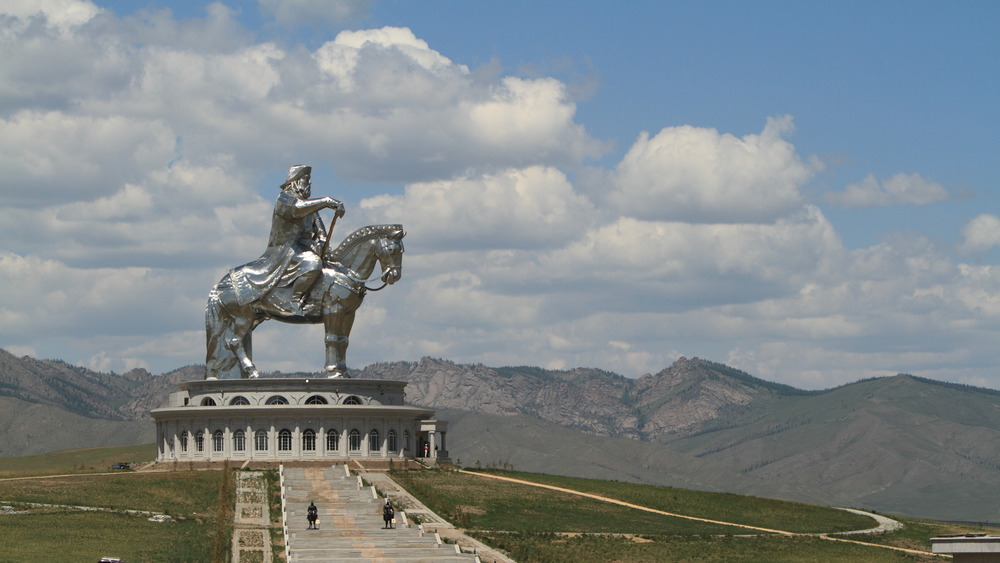
BY JOSEPH A. WILLIAMS
FEB 24, 2021
In the 1200s A.D., the world was hit by the equivalent of a human-made meteor bombardment. Cities were levelled, millions killed, and empires turned to ash. At the same time, a great part of the world became united, trade was promoted, and the stage was set for the modern era. This tsunami of change started, according to National Geographic, in 1206 when a Mongol chieftain, Temujin (sometimes Temijin) united the various tribes of the steppes of Central Asia and took the name Genghis (or Chinggis) Khan, which roughly translates to “Universal Ruler.” He was also the Khagan, a title which as described by National Geographic means the “Great Khan.” He quickly turned to the conquest of the Islamic empires in the west and the Chinese dynasties to the south.
Even after Genghis Khan died in 1227, his empire continued to grow through the conquests of his successors, leading to a Pax Mongolica, which until the empire’s end in 1368 created an enforced peace across Asia, which allowed for the expansion of trade, technology, and ideas. The cost, however, was millions of deaths and large swaths of destruction.
The tool which Genghis and his successors used to achieve all this were unparalleled warriors. They were raised with the object of warfare in mind. To be so successful, these warriors had certain rules and traditions that they had to follow. If they did not follow them then… well you shall see.
BEING A MONGOL WARRIOR IS NOT RECOMMENDED, IT IS REQUIRED
Wikimedia Commons
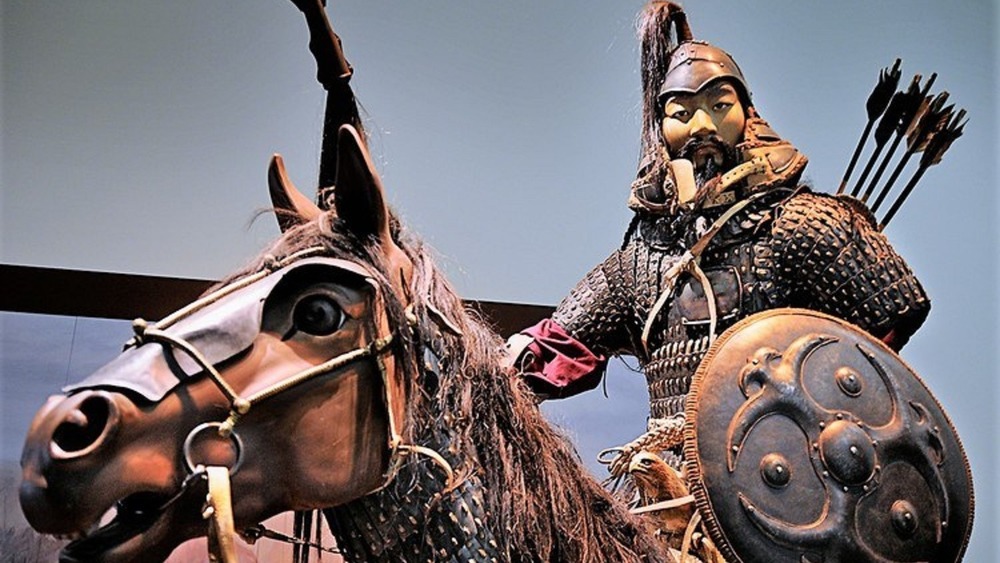
Genghis Khan was able to conquer kingdoms and empires with far larger, urbanized populations than his own. The reason for this was that Genghis Khan mobilized a much larger portion of his kingdom than other civilizations. According to Fighting Techniques of the Oriental World, all Mongolian males between the ages of 16 to 60 were liable for military service. Timothy May’s The Mongol Art of War gives this age range from 15 to 70. Either way, it is clear that a large segment of Mongol society were warriors.
This is not to say that all these men actually went to war. What it does say is that on the whole, the Mongols recruited more soldiers per capita than other peoples. May cites that one out of every seven Mongolians was a warrior in a population of almost 665,000. Genghis Khan’s army, at the time of his coronation in 1206, was 95,000. It is telling that as related by Stephen Turnbull’s Mongol Warrior, there was no term in the Mongol language for “soldier” since it was a part of every man’s being.
GENGHIS KHAN’S WARRIORS MUST-WIN DESPITE TRADITION
Wikimedia Commons
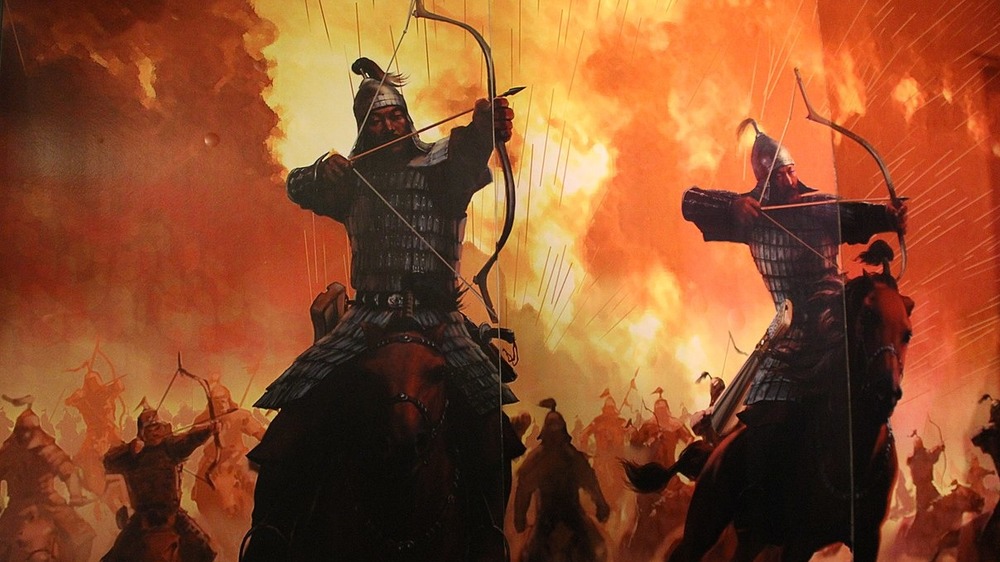
The most important thing to Genghis Khan was a victory. One world history textbook provides this gem attributed to Genghis Khan, “Man’s highest joy is in victory: to conquer one’s enemies, to pursue them, to deprive them of their possessions, to make their beloved weep, to ride on their horses, and to embrace their wives and daughters.” Maybe this is why one in two hundred men are descendants of the Great Khan today.
It is no wonder that with such a single-minded attitude that Genghis Khan was willing to throw out traditional Mongol military techniques when needed. Discover Magazine relates his flexibility. He adopted foreign ideas and technologies. When his empire began to expand, and it became clear he needed to conquer cities, he quickly adopted siege technology. This attitude was taken up by his successors who, as described by the Ancient History Encyclopedia, used rockets, naval warfare, and early gunpowder weapons to achieve victory. The Mongols even used Greek fire. Despite this, results were sometimes mixed. The Mongols after Genghis Khan launched naval invasions of Japan, which failed due to storms and major resistance. Ultimately, the core of the Mongol military machine, and what made Genghis Khan’s warriors so legendary, was its cavalry.
MONGOL WARRIORS MUST BE EXPERT HORSEMEN
Shutterstock
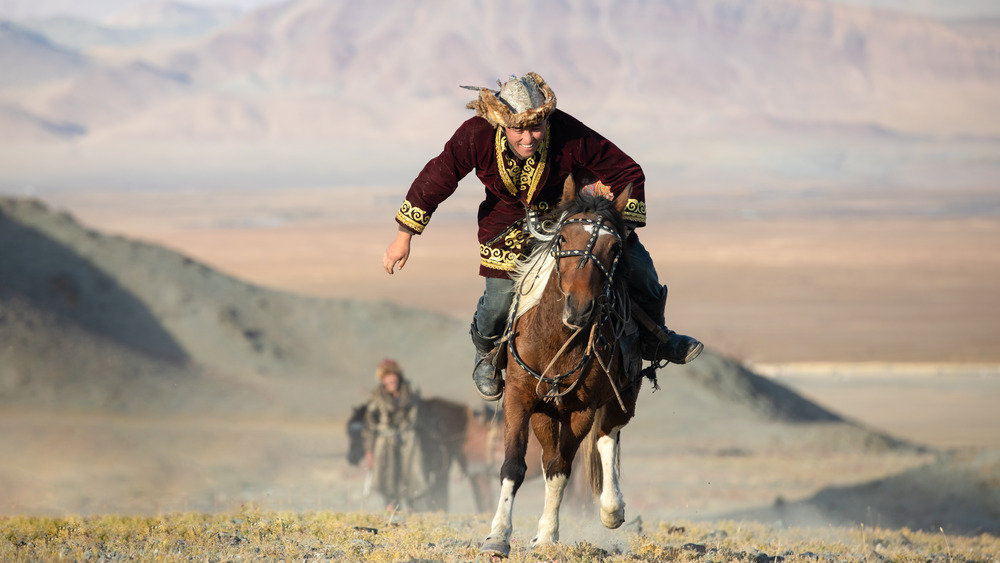
The primary factor in Genghis Khan’s success was his use of cavalry. The Mongols were nomads of the grasslands of Central Asia and depended on the horse in their daily lives. According to Daily Life in the Mongol Empire, all Mongol children were taught, by law, horsemanship. The horse was about the size of a pony. National Geographic relates that the typical Mongolian breed of horse today is 4.6-feet high and is the same breed used by Genghis Khan’s warriors. The Mongol horse’s characteristic that made it a key tool for Genghis Khan was its endurance. These horses raced across the vast Eurasian steppes and also withstood temperatures ranging from -40 to 90 degrees Fahrenheit.
Critical to Mongol success was also the use of metal stirrups. Arstechnica explains that the use of stirrups enabled Genghis Khan’s warriors to ride farther, to stay in the saddle in battle, and to effectively use the bow and arrow on the move and in all directions. When going to war, a Mongol warrior might have five or six horses with him for remounting, according to Mongol Warrior.
The Mongols and the horse are a point of cultural pride and a source of sport and competition today at the Mongol Derby. The race, which is modelled on Genghis Khan’s relay postal routes, features riders who transverse a 621-mile circuit in under ten days, changing horses at 25-mile intervals. This race is the longest equestrian endurance event on Earth.
MONGOL WARRIORS MUST DRINK BLOOD (WHEN REQUIRED)
Wikimedia Commons
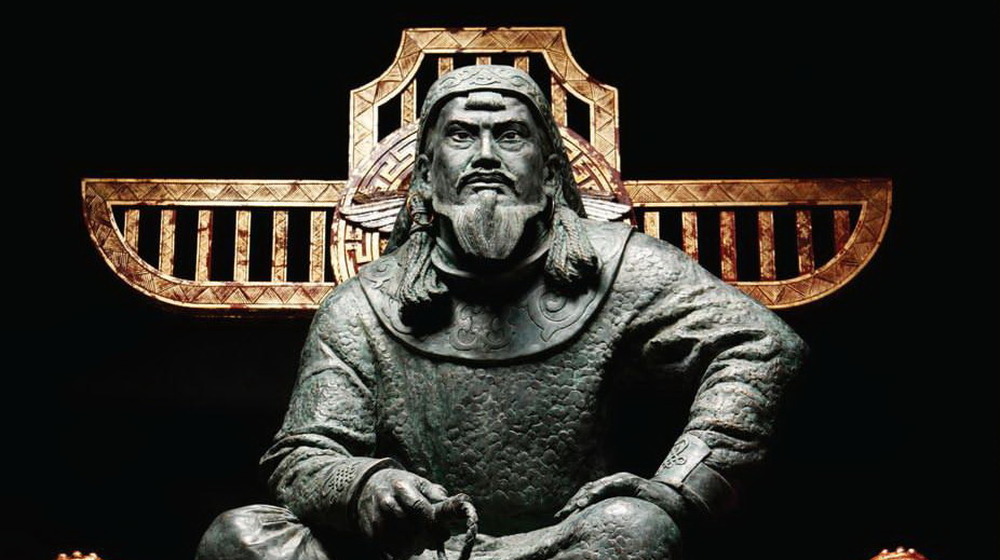
It seems pretty clear that Mongol warriors relied heavily on their horses. This was not just limited to warfare. Morris Rossabi of Columbia University relates how Mongol horsemen used horses for sustenance, while on a campaign, as a source of milk. This milk was at times fermented to create kumiss, also known as araq, which was an alcoholic beverage favoured by the nomadic people of Central Asia. If a Mongol warrior on a long journey had no other supply of water or food, he would make a slit in his horse’s neck and drink the blood for sustenance.
Marco Polo reported, “And in case of great urgency they will ride ten days on end without lighting a fire or taking a meal. On such an occasion they [the Mongol riders] will sustain themselves on the blood of their horses, opening a vein and letting the blood jet into their mouths, drinking till they have had enough, and then staunching it.” Rossabi quoted one Mongol commander as stating, “If the horse dies, I die; if it lives, I survive.” It is no wonder that Genghis Khan’s warriors had multiple horses.
GENGHIS KHAN’S WARRIORS MUST BE AMAZING ARCHERS
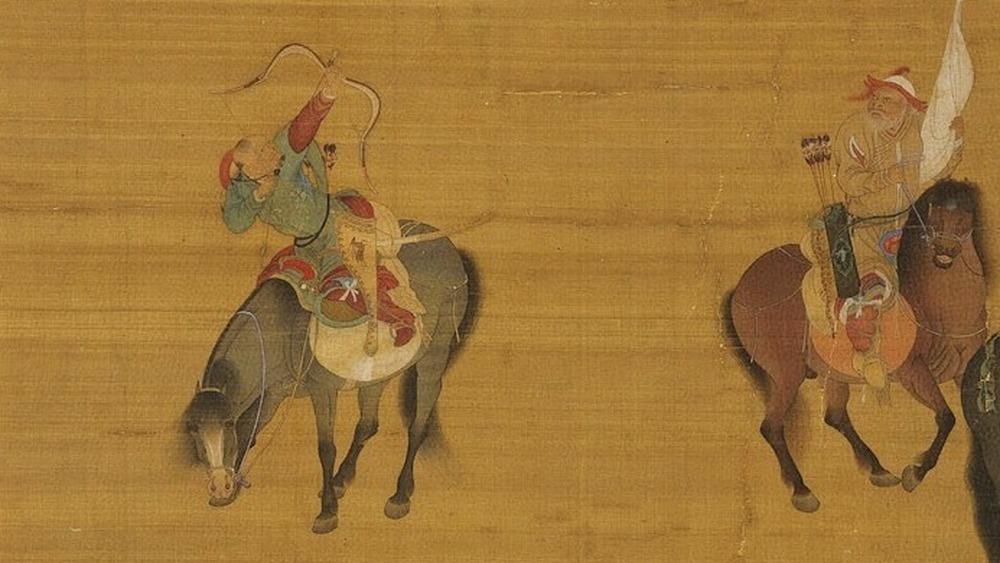
Wikipedia
To be one of Genghis Khan’s warriors, you needed to know how to be an expert bowman — especially while riding a horse. The weapon of choice for Genghis Khan’s warriors was a composite bow. In its day, it was cutting edge. Sam Fadala in Traditional Archery writes that the Mongol warrior’s bow was made of a combination of materials built off a wooden core. The bow also contained animal horns and sinews. The Mongol bow also had a unique shape. It was very recurved and powerful. An expert archer could shoot up to 500 yards and pierce armour.
Yet what made Genghis Khan’s warriors most effective was their ability to integrate their mastery of the horse with their shooting skills. According to Britannica, Mongol warriors typically carried a longbow to shoot from the ground and the shorter bow to use while on the horse. The Mongol Warrior relates there were a variety of arrowheads that Genghis Khan’s warriors chose from, including poisoned arrows to ones that could whistle in order to communicate at a distance. The arrows themselves were fletched with eagle feathers, and a warrior typically carried 60 into battle.
The horse archers used their weapons for long-range harassing tactics but also for deadly medium-range engagement. As a testament to their skill, warriors could shoot from the saddle backward at full gallop as highlighted by Medieval Islamic Civilization. Aside from bows, Mongols also carried curved swords, axes, spears, and maces.
MONGOL WARRIORS MUST BE READY TO HUNT LOTS OF WILD ANIMALS AT THE SAME TIME
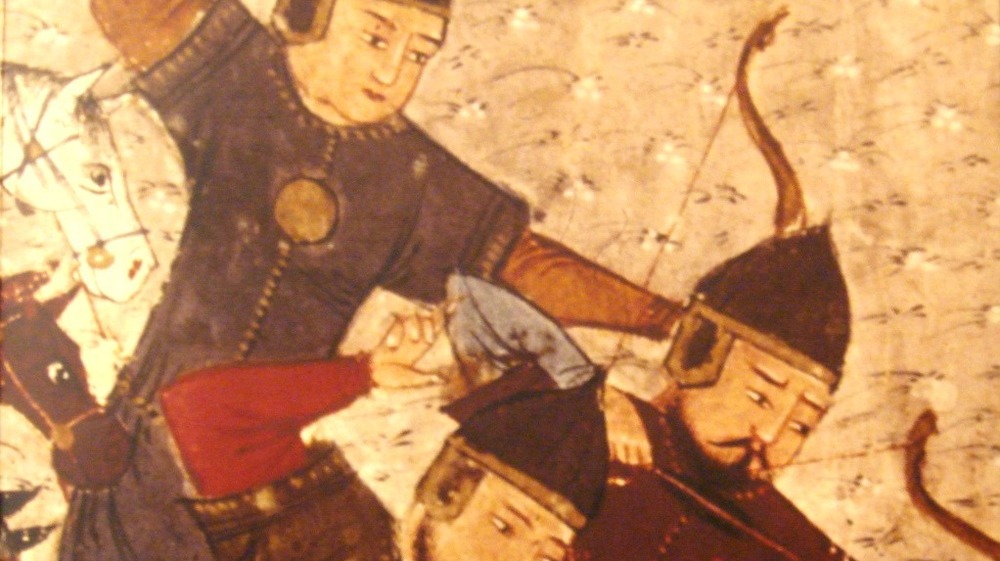
Wikipedia
Genghis Khan and his warriors were the product of a nomadic culture whose lifestyle prepared them for war. Cultural events were used as training exercises. One example of this was the merge or Great Hunt. The nerge, according to Daily Life in the Mongol Empire, was at its simplest a hunting circle. However, Genghis Khan reinvented the pastime to become an earnestly serious training exercise. Over a vast distance, an army of organized warriors chased, enveloped and encircled all the animals in a given area. Once the encirclement was complete and all the game trapped, the circle started to contract until a killing field was presented.
To give you an idea of how large-scale the nerge was, the initial line of hunters could around 80-miles long and involve multiple units of 10,000 men each. At the point of almost complete contraction, there was utter pandemonium among the entrapped animals, ranging from lion to bear to deer, all bellowing, roaring, and bleating. The khan slew the first animal before Mongol nobility took a turn and then the soldiers. After the mass slaughter, nine days of feasting followed.
The nerge took intense coordination and was run as a military drill. Communication, martial skill, and organization were critical to a successful hunt. Warriors who did not do what they were supposed to do were punished, some by execution. The circling tactics of the nerge were directly transferred into Mongol military tactics.
GENGHIS KHAN’S WARRIORS MUST RETREAT TO ACHIEVE VICTORY
Wikipedia
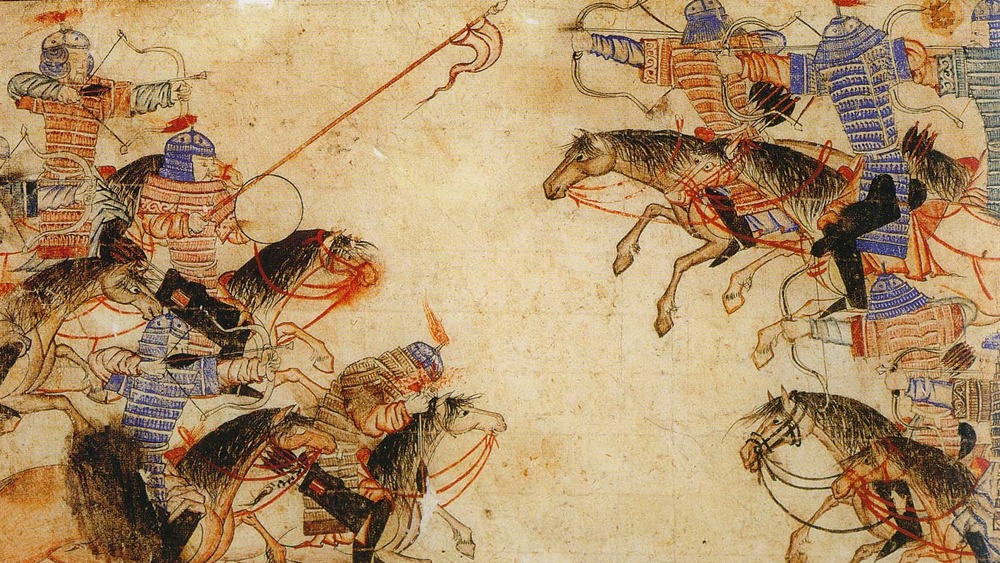
Genghis Khan was a military genius who used the strengths of his people to deadly effect capitalizing on extreme speed and surprise. According to Mongol Warrior, the Mongolian army used scouts in force, often riding up to 70 miles ahead of the main body of troops. This meant that any enemy who came in contact with the Mongol army would alert its centre which, using its superior mobility, moved to encircle it like the nerge. This was often accomplished through the use of strategic retreats. A detachment of warriors engaged a hostile force, then suddenly turned and withdrew. This baited the enemy army into pursuing them. As they did so they were drawn deeper into a trap. Their lines were stretched out. Then the wings of the Mongol army snapped shut as the retreaters now turned and gave battle.
This tactic was highly successful even when the Mongol’s enemies were very much aware of their use. After successfully disrupting the enemy through these methods, the final blow usually came from Mongolian heavy cavalry armed with melee weapons.
These tactics were fruitful for Genghis and his successors. The Encyclopedia of Ancient History notes that in most battles, the Mongols were outnumbered, but they won anyway because of these superior tactics.
MONGOL WARRIORS MUST NOT WANT A SALARY
Wikipedia
In almost all cases, the Mongol warriors led by Genghis Khan neither earned a salary nor had a 401(k) plan. Yet, according to the Mongol Warrior, each soldier could expect to become rich under the khan from booty. The Cambridge History of War relates how Genghis Khan decreed that all warriors would receive a share of the spoils of war but only after the enemy was completely annihilated.
What this meant practically was that splitting up the loot was not a free-for-all. Everything was collected and then distributed, so if a Mongol detachment was in hot pursuit of a fleeing enemy, it wouldn’t get distracted to go loot a merchant caravan and the like — his fellow warriors would do it, and he would still receive a share of the total spoils. To enforce this rule, the Mongols had a judicial body called the jarqu, which according to Paul Buell’s The A to Z of the Mongol World Empire, ensured a lawful distribution of booty.
MONGOL WARRIORS DO NOT CARE WHO YOUR PARENTS ARE
Wikipedia
One often underlooked feature of Genghis Khan’s war machine was that it was an equal opportunity employer. Paula Sabloff in her book, Modern Mongolia, asserts that in 1206, Genghis Khan created the empire’s first law code, which established rule of law. This enabled Genghis Khan to promote some form of equality in Mongol society. This concept transferred to his army, which promoted warriors based on skill and valor. A commoner could achieve high rank in the empire by merit of ability alone.
This was not just limited to men. Mongol women, while still limited, were in comparison to other cultures around the world, given remarkable freedom acting as political advisors to the khan. One woman, Khutalun, who lived a generation after Genghis Khan, was known for her physical strength and wrestling prowess. In Morris Rossabi’s biography, Kublai Khan, he relates her military skills and how she regularly defeated men in wrestling contests. This equanimity was related by the Persian historian Ata-Malik Juvaini who wrote that the Mongol army was like “…a peasantry in the guise of an army, all of them, great and small, noble and base, in time of battle becoming swordsmen, archers and lancers and advancing in whatever manner the occasion requires.”
As Genghis Khan’s empire grew, he recruited from other peoples. While, as Mongol Warrior relates, they were not Mongol warriors in the strictest sense, serving as footmen and auxiliaries, they were critical in allowing Genghis Khan to achieve his imperial ambitions.
GENGHIS KHAN’S WARRIORS MUST BE OKAY WITH TERROR TACTICS
Wikimedia Commons
Genghis Khan was one of the most successful generals in history, not just because of his tactics on the battlefield but also because of the terror he inspired in his enemies. According to Medieval Warfare, Genghis Khan led the wholesale destruction of the Khwarizmian Empire, which included extensive looting, genocide, and destruction. After the conquest of the city of Bokhara, Genghis Khan as quoted in George Lane’s Genghis Khan and Mongol Rule, said to the vanquished, “…I am the punishment of God. If you had not committed great sins, God would not have sent a punishment like me upon you.”
Mongol Warrior relates numerous instances of Genghis Khan and his successors slaughtering entire populations if they did not surrender. In one example, according to Jack Weatherford’s Genghis Khan and the Making of the Modern World, the city of Urgench near the Aral Sea resisted Genghis Khan’s armies for six months. Even after the Mongols breached the city’s walls, the citizens resisted in the ruins. In order to deal with this unacceptable situation, the Mongols diverted a river by building a dam. They then flooded the city, killing the remaining defenders, laying Urgench waste. In another instance reported by Discover Magazine, Mongol warriors used captives as body shields while besieging a city.
According to Britannica, approximately 40 million people were killed due to Genghis Khan’s conquests, particularly in China and Iran.
BUT MONGOL WARRIORS MUST BE TOLERANT
Shutterstock
With all the blood and gore you just read about, you might think that living under Mongol rule must have been horribly repressive. As strange as it sounds, the Mongol empire, starting with Genghis Khan, had fairly tolerant attitudes, at least toward religion. According to Columbia University, while the Mongol practiced their own shamanism, they felt it was a wiser decision to let the people they had just subjugated practice their own religion. In fact, they even went so far as to promote various religions with the belief that it would make the empire easier to rule.
Columbia also notes that Genghis Khan provided tax relief to favored religions such as Buddhism. Genghis Khan himself favored Taoism because they pledged they could prolong the khan’s life. While he never converted to any religion, his relationship with a Taoist sage led to the creation of one of the major primary sources on Genghis Khan. Keep in mind that toleration was limited. Absolute obedience to the Great Khan was paramount.
GENGHIS KHAN’S WARRIORS MUST OBEY OR DIE
Wikipedia
The most important rule that Genghis Khan’s warriors had to follow was obedience. The Mongol armies were organized in a strict hierarchy. The Mongol Warrior relates that punishments were doled out to enforce military order. If a warrior dropped his pack or bow, then the warrior behind him was required to retrieve it or be punished. If a soldier was found to be missing gear, then the officer in charge of that man was punished.
Minor offenses were dealt with by a cane beating, which rose as the number of offenses increased, topping out at 37. More severe offenses resulted in execution. This included sentries falling asleep at their post, plundering without permission, retreat without permission, and desertion. Friar Giovanni di Plano Carpini admired Mongol warrior discipline writing, “These men … are more obedient to their masters than any other men in the world, be they religious or seculars … They rarely or never contend with each other in word, and in action never. Fights, brawls, wounding, murder are never met with among them.”
The Mongols built the largest contiguous empire in history through their skilled warriors, but in the end, the way they built it hastened its own demise. When the empire fragmented several generations after Genghis Khan, the inhabitants of the conquered regions took pains to try to wipe the memory of the Mongols from history. Yet this was impossible, since the conquests of Genghis Khan and his warriors changed the world forever.
RECOMMENDED
Stars Who Have The Grossest Personal Hygiene In All Of Hollywood
The Truth About Donald Trump’s Youngest Son is Out Now
Terrifying Werewolf Movies That Give Us Chills Every Time
Actors Who’ve Died In 2021 So Far
NEXT UP
HOW MANY CHILDREN DID GENGHIS KHAN REALLY HAVE?
Shutterstock
BY ZACH LISABETH/FEB. 10, 2020 2:22 PM EDT
To the victor goes the spoils, as they say, and Genghis Khan was nothing if not victorious. On his bloody march across Asia, he claimed a lot of — well – spoils. The “Great Khan” and ruler of the medieval Mongolian Empire, lived from approximately 1162-1227. He was born in the war-ravaged region along the modern border of Siberia and Mongolia. Over the course of his violent life, he united several warring Mongol tribes into an organized army that conquered wide swathes of Asia. He accomplished this task where other Mongolian warlords had failed by claiming several different wives and concubines from the competing tribes and petty kingdoms in the region.
Genghis Khan came by this strategy honestly. His father actually kidnapped his mother from a warring tribe and sired Genghis to consolidate his own power in the region. Genghis, known early in his life as Temujin, took his father’s game to the next level, claiming at least six Mongolian wives and over 500 concubines. Despite these prodigious numbers, evidence suggests that the Great Khan made time for all of them and that their unions were … productive. So how many children sprang forth from this fecund general’s loins?
GENGHIS KHAN SPREAD HIS SEED
Shutterstock
An historical genetics study concluded in 2003 showed that as many as 16 million living men were likely direct-line descendants of Genghis Khan. The researchers found to their ample surprise that about 1 in 200 males alive at the time of the study had genetic indicators on their Y-chromosomes suggesting they were all descended from a single male “super father” living approximately 1,000 years ago. In other words, Genghis may have been on horseback, but that dude got around. This result suggests that the Great Khan may have produced hundreds of sons by his concubines and younger wives that were never formally recognized and therefore went unrecorded by history. So how many biological sons did Khan have? Probably a ton, even though we can’t exactly know.
But there’s another answer to this question. According to Mongolian law at the time, rulers had to derive from a Golden Lineage. This means Genghis Khan likely only recognized his four sons by his first wife as actual sons. These four Mongolian heirs — Jochi, Chagatai, Ogedei and Tolu — inherited the Khan name, even if hundreds of others may have inherited the Khan DNA.
RECOMMENDED
It’s Clear Why Nobody Wants To Work With Jennifer Aniston
The Worst Main Character In HIMYM Might Surprise You
Disturbing Facts That Were Discovered In Celeb Autopsy Reports
John Travolta’s Done Some Creepy Things, These Are The Creepiest
NEXT UP
ANCIENT LEADERS WHO WERE REALLY WEIRD PEOPLE
Shutterstock
BY BECKI ROBINS/JULY 25, 2018 10:14 AM EDT
To say that some ancient leaders were really weird is probably a bit of an understatement. Being really weird was almost a prerequisite for being an ancient leader.
Ancient leaders in particular were under a lot of pressure to be all-knowing, all-powerful, and to also figure out what to do with thousands of concubines. With those kinds of expectations, it’s no wonder that so many of them went a little bit bonkers or were just exceedingly strange in general. In their defense, though, it’s pretty difficult to not be weird when you have the absolute power to solve your most stupid, random little problems in the most cruel and bizarre ways possible, and you can do so without fear of consequences. The only thing we should really find surprising about that is that anyone who ruled the ancient world managed to actually make it to the end of their reign without destroying their entire kingdom in some ridiculous, self-centered way.
LIKE FLIES TO NAKED SLAVES COVERED WITH HONEY
Shutterstock
We can all agree that flies are awful. They walk around on picnics with their poop-covered little feet and they land on the TV and crawl up Jon Snow’s nose while he’s in the middle of saying something profoundly gloomy. But most people deal with flies by swatting them, or maybe chasing them with a tennis racket-shaped bug zapper. If you’re an ancient leader, though, not only can you develop truly novel ways to deal with flies but you can do it in the most cruel way possible because what’s the point of being an ancient leader if you can’t also be a sadistic jerk?
The Pharaoh Pepi II ruled Egypt around 4,300 years ago. He reigned for between 64 and 94 years (sources differ) and he really, really disliked flies. In fact, according to The Telegraph, he disliked flies so much that he devised a unique way of dealing with them: He’d pour honey on random naked slaves, turning them into living stick-a-flies. Evidently this was pretty effective, but if it was really just the honey that did the job, one has to wonder why Pepi couldn’t have just smeared honey all over a statue of his least favorite relative or something. Of course, it’s hard to be a sadistic jerk if you’re only humiliating a statue. Priorities.
A HORSE, A HORSE, THIS CONSULSHIP FOR A HORSE
Shutterstock
Most Roman emperors were bonkers. You kind of had to be to handle all that empire. But some Roman emperors took bonkerdom to an extreme level, and Caligula was the most bonkers of all bonkers Roman emperors.
SPONSORED BY /CA.EYEBUYDIRECT.COM
You’ve Never Found Glasses This Way Before
Read More
You may remember Caligula as the dude who made his horse a consul. Now, you have to bear in mind that ancient historians really didn’t have a ton of incentive to make sure their histories were accurate — they were more like the Philippa Gregories of antiquity, embellishing in some places and just flat out making stuff up in others. According to History, much of what we know about Caligula comes from a historian who lived several decades after his death, so all those stories about Caligula having meaningful conversations with the Moon and feeding his horse oats mixed with flakes of gold might not be true.
Some historians point to other legends, like the one that says during a campaign in Britain he told his soldiers to stop what they were doing and collect seashells. He supposedly once ordered a bunch of boats to line up and make a bridge across the Bay of Naples so he could gallop gleefully across it. And he was eventually assassinated by his own Praetorian Guard, which is not something that tends to happen to beloved rulers.
WINE, MEAT AND 3,000 NAKED PEOPLE
Shutterstock
Who among us hasn’t dreamed of having an entire swimming pool full of whatever it is we most like to guzzle, whether it’s chocolate syrup, beer, or tomato basil soup with crumbled blue cheese? It’s really just a pipe dream, though, because even though there are plenty of people who probably could afford to fill a swimming pool with whatever beverage or light lunch they’re currently obsessed with (looking at you, Elon Musk) no one is actually crazy enough to do it (except maybe Elon Musk).
SPONSORED BY /KIJIJI CANADA
10ft x 10ft Gazebo Tent BRAND NEW
Read More
Chinese emperors, though, would totally do that. According to Ancient Origins, Zhou Xin (who ruled China roughly 3,000 years ago) had an entire lake full of wine created. But because that wasn’t excessive enough, there was also an island with “trees of meat,” and that’s not a metaphor, that’s a literal description: On each “tree” was a bunch of skewered, roasted meat. So the emperor could paddle across his lake of wine, grab himself a cup of merlot as he disembarked and then pluck meat off the trees. He would also invite thousands of people over and tell them to frolic naked in the lake of wine, and that’s full frolicking with all the extras. Now, we’re not actually sure how you chlorinate a lake of wine after 3,000 people have been full frolicking in it, but ew. Even Elon Musk would have to admit that the ick factor far outweighs the awesomeness.
WHAT IS IT THEY SAY ABOUT GILDED CAGES, AGAIN?
Shutterstock
It doesn’t take a psychotherapist to know that if you raise your kid in a prison, your kid will grow up to be weird — even if you name that prison something nice, like “the golden cage.”
The Ottoman Empire wasn’t actually “ancient” history, but it reads a little bit that way. The Ottoman princes lived in a “golden cage,” which was basically just a windowless chamber where they would spend all their time so as not to do anything troubling like overthrowing the current ruler or getting daily exercise. That was life until they ascended to the throne.
According to The Ottomans, when Ibrahim’s brother died in 1640 and it was his turn to take the throne, he was so insane from years of confinement that he refused to come out of the cage unless he saw his brother’s corpse. And after he did come out, he did nothing except hang out with his harem and roll around on furs. He was so obsessed with furs, in fact, that the French called him “the fur-man.”
Ibrahim kept fish and fed them with coins instead of actual food, though presumably someone else later came along with the fish flakes since the fish otherwise wouldn’t have lasted very long. And one night in a fit of insanity he had all 280 of his concubines put into sacks and drowned in the Bosphorus. But at least he still had his furs.
WHAT HE LACKED IN HAIR HE MADE UP FOR IN SADISTIC CRUELTY
Wikipedia
The Roman emperor Domitian, who ruled from 51 to 96 A.D., was bald as a cue ball and really didn’t want anyone to know about it, so he made sure artists always portrayed him with flowing locks. Did he have a flowing lock wig he used for public appearances, too? Because that’s a pretty difficult lie to perpetuate when the whole Roman Empire knows who you are.
Domitian was cruel and also really into arena sports, which was a terrible combination in a Roman emperor. He especially liked to watch gladiatorial combat between women and dwarves, and his sadistic personality also spilled over into his relationships with others. He liked to psychologically torture those he planned to kill — according to Mad Monarchs, he would sometimes invite enemies to a friendly dinner, send them home that night feeling safe and secure, and then surprise them with an executioner first thing the next morning.
Like so many other Roman emperors, Domitian had a god complex but his was especially obnoxious: He insisted on being called “master and god,” which the aristocracy almost certainly would have found funny if it weren’t for the whole wine-dine-death thing. Oh and he also hated flies and enjoyed torturing them by stabbing them with a pen and tearing their wings off.
A DECISION SO DIFFICULT ONLY A GOAT COULD MAKE IT
Shutterstock
Ancient Chinese rulers usually had bunches of concubines. Some of them had so many concubines that if they spent one night with each one it would take years to get through the whole lot.
Emperor Wu, who took the throne of China in 265, defeated his rival Sun Hao and then ended up with an extra 5,000 concubines. Suddenly the great emperor found himself paralyzed with indecision because how exactly does one decide which of 5,000+ concubines to spend the night with?
If you answered “goats,” you’re like no one else ever in the history of anything because having goats decide the trajectory of your love life is straight-up crazy. But according to the Biographical Database, that’s exactly what Emperor Wu did — he climbed aboard a little cart pulled by goats, let them go wherever they felt like going, and then he’d spend the night in the first place where they stopped, which for his sake was hopefully not the pasture where all the rest of the goats were.
Anyway, the ladies knew this, so they would put salt licks and bamboo and other things goats are into in front of their doors in hopes that the emperor would stop. And then they would try to pretend like they weren’t romancing a crazy person whose social life was controlled by ruminants.
A BITING SENSE OF HUMOR
Shutterstock
In 565 A.D. an emperor named Justin II rose to the throne of Byzantine, and for a while he was a pretty okay emperor. He expanded the empire by acquiring lands in southern Europe and Italy, and he was fairly tolerant of religious differences in his kingdom. But then, according to ThoughtCo, he made the dubious decision to invade Persia, which went less than swimmingly. Not only were the Persians totally not cool with being invaded, they also decided to do a little reciprocal invading, and pretty soon the Byzantine city of Dara was in Persian hands.
At this point, Justin started behaving badly, much in the same way as history’s other Justin (Biebers) have. Instead of drunken chariot racing and resisting arrest, though, this particular Justin mostly just bit everyone who came close to him and ordered his musicians to constantly play organ music in the hope that it might help calm his nerves. Ah yes, the calming tones of an organ. Justin’s wife was finally able to convince him to adopt as his son a military leader called Tiberius — Tiberius took over Justin’s royal duties and eventually became the new emperor of Byzantine. Here’s hoping his first royal decree was to put an end to the organ music.
GIVE ME THAT HAT, I HAVE TO PEE
Shutterstock
Lots of people didn’t love college, or high school, or school in general, but though you may have dreamed of urinating on your economics textbook or in the shoe of your snoring roommate, you would never actually do anything like that because you’re not weird, and also not an emperor who lived a couple millennia ago.
The Chinese Emperor Liu Bang did not like Confucian teachings. In fact, he was so hostile to Confucian scholars that he was fond of grabbing the hats off their heads and literally peeing in them.
Now, this story could take on several additional levels of awful if a) Liu Bang would return the hat to the scholar after peeing in it or b) force him to put it back on, but our source didn’t elaborate. Still, peeing in someone’s hat is pretty weird behavior, and evidently Liu Bang’s dislike of scholars persisted until one of his advisers eventually convinced him that he could conquer a kingdom with force but only keep it with knowledge. After that Liu Bang became somewhat more open to the teachings of Confucianism and hopefully found more appropriate places to urinate.
LET’S PRETEND I’M NOT CRAZY
Shutterstock
Zhu Houzhao came to the throne when he was 13 years old, which is actually not that young by ancient ruler standards but is absolutely insane from the point of view of anyone who’s ever tried to convince a modern 13-year-old that true responsibility goes far beyond remembering to charge your cell phone every night. Most 13-year-olds can’t be trusted to brush their teeth consistently, let alone rule an entire kingdom. So when Zhu Houzhao rose to power it shouldn’t have been too surprising that he wasn’t ready to leave his childish pursuits behind him. Unfortunately, his childish pursuits did not just consist of first-person shooters and sleeping until lunchtime. Zhu Houzhao liked to pretend-play, and that meant that his entire entourage had to also pretend-play or fear the typical angry-ruler-smiting of the time.
According to historian David M. Robinson, the emperor’s games ranged from rather harmlessly pretending to be a shopkeeper to roaming the streets in disguise and kidnapping the daughters of wealthy families. He also invented an alter ego named Zhu-Zhu, mostly so he could tell everyone how awesome Zhu-Zhu was. And this wasn’t just something he did while he was still technically a kid — Zhu Houzhao kept on acting like a child until he fell out of his fishing boat into the Grand Canal, nearly drowned, and languished for a few months until he died at the age of 29.
RELIGIOUS INTOLERANCE
Getty Images
Imagine if the leader of your nation decided everyone had to start worshiping a smiley-face. And also, all evidence of the old religion would be erased and replaced with pictures of the smiley-face.
The pharaoh Akhenaten’s god wasn’t exactly a smiley face but it was literally a yellow circle with rays coming out of it, and Akhenaten told everyone it was the one and only god, which was quite shocking and upsetting for a population that had always had seriously badass jackal-headed gods and eagle gods and zombie gods.
According to LiveScience, Akhenaten (called “the heretic king” by his own people) was so obsessed with his lame sun god disk thingy that he built a whole new capital in the god’s honor, and he chose the location mostly because the sunrise looked cool there. The new city prospered until Akhenaten’s death, when pretty much all of Egypt set out to not only pretend like he never existed but also erase him from history, much in the same way he’d tried to erase the old gods. They were so successful, in fact, that no one ever heard of Akhenaten until the 19th century, when some inscriptions were found that mentioned his name.
Incidentally, Akhenaten is now credited with spearheading the world’s oldest known monotheistic religion. He was also the father of the most famous pharaoh of them all: King Tut. Not bad for a weird heretic king.
ARE YOU MAKING FUN OF ME?
Shutterstock
Ancient leaders were programmed to be extra-paranoid. First, there was the problem where there was always someone who wanted to overthrow you, and anyone not trying to overthrow you this week was going to try next week. So you were constantly on the lookout for poison, assassins, and honey-covered slaves who were really sick of standing around attracting flies all day long. That kind of paranoia was bound to nurture lesser paranoias, which would often morph into irrational behavior.
Such was the case of Fu Sheng, who was blind in one eye and was sure everyone was making fun of him for it. In fact he was so sure that he not only made it a crime to talk about his one lesser eye, but to talk about one lesser anything. According to Ancient Origins, Fu Sheng banned the words “less,” “lacking,” “missing,” and “without,” which means if you were hanging out with Fu Sheng and you said the words, “Crap, I left the house without my coin purse this morning,” you’d be executed.
Fu Sheng wasn’t just a jerk about the whole eyeball thing, he was pretty much just an all-around jerk. When his astrologers prophesied that there was going to be some major royal death in China if he didn’t mend his ways, he decided he was just going to fulfill the prophecy deliberately. So he executed his wife, his father-in-law, and his uncle. Take that, prophets.
Read More: https://www.grunge.com/101210/queens-really-weird-people/?utm_campaign=clip

Leave a Reply
You must be logged in to post a comment.